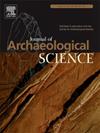Insects in the far West: Burial practices on El Hierro Island (Canary Islands, Spain; ca. 6th-11th centuries) reconstructed via funerary archaeoentomology
IF 2.6
1区 地球科学
Q1 ANTHROPOLOGY
引用次数: 0
Abstract
The Canary Islands were first settled by North African groups in the first millennium CE and, after a few centuries of interconnections with the mainland and between islands, remained isolated until the late medieval European expansion into the Atlantic. El Hierro is a small island located in the westernmost part of the archipelago that was inhabited by the bimbapes from the 2nd century CE until the 15th century European conquest. The archaeological records, including marine food processing sites and cave burials, illustrate their adaptation to the environment: the dependence on marine resources for its economy owing the island's isolation and the scarcity of arable land and the use of the natural landscape to dispose of deads. La Lajura Cave, a collective burial site used from the 6th to 11th centuries CE, revealed significant anthropological and entomological findings. The archaeoentomological analysis of the sediment samples revealed 5816 insect remains, primarily Diptera and Coleoptera, with relatively small numbers of Hymenoptera, Heteroptera, Lepidoptera, and Arachnida. These findings shed light on decomposition processes and funerary practices as well as the distribution of the cadaveric entomofauna present in the western limit of the Palearctic region before the modern era. This study highlights the role of insects in cadaveric decomposition and their ecological behaviors, offering valuable insights into the funerary practices of Bimbape society in a unique ecological context.
遥远西方的昆虫:耶罗岛(西班牙加那利群岛)的埋葬习俗;约6 -11世纪),通过丧葬考古昆虫学重建
加那利群岛最早在公元一千年由北非群体定居,在与大陆和岛屿之间建立了几个世纪的联系之后,一直处于孤立状态,直到中世纪晚期欧洲人向大西洋扩张。耶罗岛是位于群岛最西端的一个小岛,从公元2世纪到15世纪被欧洲人征服,这里一直是bimbape人居住的地方。考古记录,包括海洋食品加工地点和洞穴墓葬,说明了他们对环境的适应:由于岛屿的孤立和可耕地的稀缺,其经济依赖海洋资源,并利用自然景观处理死者。拉拉朱拉洞穴是公元6世纪至11世纪使用的集体墓地,揭示了重要的人类学和昆虫学发现。经考古昆虫学分析,共发现5816具昆虫遗存,以双翅目和鞘翅目为主,膜翅目、异翅目、鳞翅目和蛛形目数量较少。这些发现揭示了分解过程和丧葬习俗,以及现代之前古北地区西部存在的尸体昆虫动物群的分布。这项研究强调了昆虫在尸体分解及其生态行为中的作用,为在独特的生态背景下了解Bimbape社会的丧葬习俗提供了有价值的见解。
本文章由计算机程序翻译,如有差异,请以英文原文为准。
求助全文
约1分钟内获得全文
求助全文
来源期刊

Journal of Archaeological Science
地学-地球科学综合
CiteScore
6.10
自引率
7.10%
发文量
112
审稿时长
49 days
期刊介绍:
The Journal of Archaeological Science is aimed at archaeologists and scientists with particular interests in advancing the development and application of scientific techniques and methodologies to all areas of archaeology. This established monthly journal publishes focus articles, original research papers and major review articles, of wide archaeological significance. The journal provides an international forum for archaeologists and scientists from widely different scientific backgrounds who share a common interest in developing and applying scientific methods to inform major debates through improving the quality and reliability of scientific information derived from archaeological research.
 求助内容:
求助内容: 应助结果提醒方式:
应助结果提醒方式:


